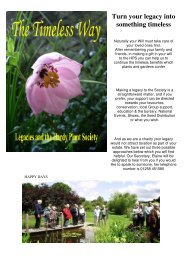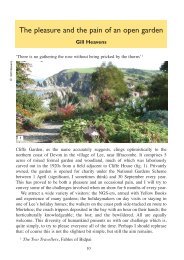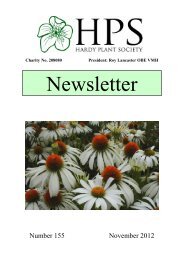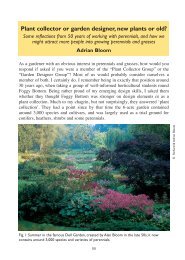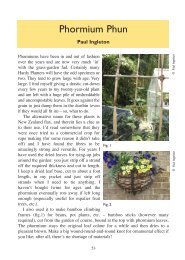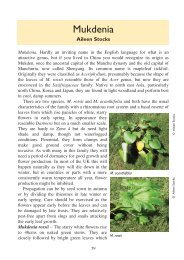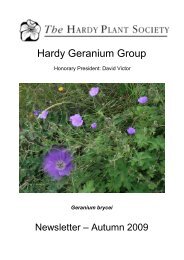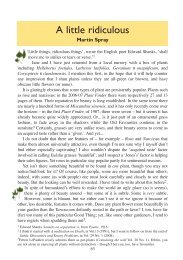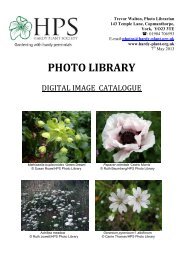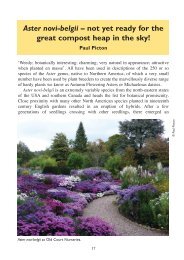On the road in search of lilies - Hardy Plant Society
On the road in search of lilies - Hardy Plant Society
On the road in search of lilies - Hardy Plant Society
You also want an ePaper? Increase the reach of your titles
YUMPU automatically turns print PDFs into web optimized ePapers that Google loves.
<strong>On</strong> <strong>the</strong> <strong>road</strong> <strong>in</strong> <strong>search</strong> <strong>of</strong> <strong>lilies</strong><br />
Alan Mitchell<br />
Readers <strong>of</strong> a certa<strong>in</strong> age and literary<br />
taste will recognise that <strong>On</strong> <strong>the</strong> Road is<br />
an allusion to Jack Kerouac’s classic tale<br />
<strong>of</strong> roam<strong>in</strong>g around America. So at this<br />
po<strong>in</strong>t let me allay any concerns about<br />
what might come next: <strong>the</strong> trip I made<br />
was, thankfully, short on rebellious<br />
behaviour and existential angst, but full<br />
<strong>of</strong> encounters with most <strong>of</strong> California’s<br />
beautiful species <strong>lilies</strong> and some <strong>of</strong> <strong>the</strong>ir<br />
perhaps slightly wayward, but naturally<br />
occurr<strong>in</strong>g, hybrid <strong>of</strong>fspr<strong>in</strong>g.<br />
The metaphorical <strong>road</strong>, preced<strong>in</strong>g <strong>the</strong><br />
actual 1500 miles <strong>in</strong> <strong>search</strong> <strong>of</strong> <strong>lilies</strong>,<br />
began when I met Charlie Kroell at <strong>the</strong> Fig. 1 L. kelloggii<br />
2004 RHS Lily Conference, and spoke<br />
<strong>the</strong> words “L. henryi var. citr<strong>in</strong>um”. This yellow variety <strong>of</strong> <strong>the</strong> orange type <strong>of</strong> L.<br />
henryi has a strong fasc<strong>in</strong>ation for Charlie, as has <strong>the</strong> legend that it is a hybrid<br />
which was orig<strong>in</strong>ally discovered <strong>in</strong> a garden <strong>in</strong> Melrose, Massachusetts <strong>in</strong> 1925.<br />
Whatever <strong>the</strong> truth <strong>of</strong> <strong>the</strong> matter, i.e. species variety or hybrid, it was this mystery,<br />
debated through many lengthy emails, that led to our friendship and later Charlie’s<br />
suggestion that I might enjoy what he called a “lily chase” <strong>in</strong> California.<br />
As Charlie knew about my preference for species <strong>lilies</strong> ra<strong>the</strong>r than hybrids, he<br />
thought <strong>the</strong> prospect <strong>of</strong> see<strong>in</strong>g a number <strong>of</strong> western American species grow<strong>in</strong>g <strong>in</strong><br />
<strong>the</strong>ir natural environments would appeal, as would driv<strong>in</strong>g through <strong>the</strong> Canadian<br />
Rockies to <strong>the</strong> NALS Convention <strong>in</strong> Edmonton. I emailed Charlie to count me <strong>in</strong>.<br />
The o<strong>the</strong>r members <strong>of</strong> <strong>the</strong> lily chase foursome were Barbara Small (a native<br />
Californian whose local lily-knowledge was essential to <strong>the</strong> trip’s success) and<br />
Kathy Andersen (who had just returned from plant hunt<strong>in</strong>g <strong>in</strong> Ch<strong>in</strong>a).<br />
Some months later I met Charlie and his wife Marijean at Detroit airport and was<br />
welcomed to <strong>the</strong>ir home <strong>in</strong> Michigan. Charlie had already arranged visits to <strong>the</strong><br />
gardens <strong>of</strong> some <strong>of</strong> his friends: Betty Sturley had a plant <strong>of</strong> L. michiganense <strong>in</strong><br />
flower, a f<strong>in</strong>e <strong>in</strong>troduction to <strong>the</strong> many American species I was to see, appropriately<br />
grow<strong>in</strong>g <strong>in</strong> its home state; Jacques Thomson had ano<strong>the</strong>r L. michiganense, which<br />
49<br />
© Alan Mitchell
© Alan Mitchell<br />
Fig. 2 Ditch liliy L. pardal<strong>in</strong>um<br />
had flowers <strong>of</strong> a richer red than Betty Sturley’s, an example <strong>of</strong> variation with<strong>in</strong> a<br />
species that became more apparent when consider<strong>in</strong>g species like L. kelloggii<br />
(fig. 1) and L. pardal<strong>in</strong>um (fig. 2) <strong>in</strong> <strong>the</strong>ir natural, Californian habitats.<br />
The flight to Reno was uneventful and after collect<strong>in</strong>g our rental vehicle, a fairly<br />
large 4x4 with excellent air condition<strong>in</strong>g – essential <strong>in</strong> temperatures that, except for<br />
part <strong>of</strong> a day spent <strong>in</strong> drench<strong>in</strong>g Scots mist, ranged from 30–40°C – it wasn’t long<br />
before we were head<strong>in</strong>g across <strong>the</strong> Nevada/California State border by way <strong>of</strong> Verdi,<br />
(as <strong>in</strong> Guiseppe Verdi, but pronounced to rhyme with pie) to locate our first lily <strong>of</strong><br />
<strong>the</strong> trip, L. chrystalense. For readers who do not recognise this American species<br />
<strong>the</strong>re is an explanation: this lily has not yet achieved specific rank, but if Barb has<br />
her way it will, as she feels it is different enough from L. parvum (fig. 3) and L.<br />
pardal<strong>in</strong>um not simply to be labelled as a hybrid <strong>of</strong> those established species. This<br />
lily grows <strong>in</strong> restricted oases beside streams and aspen trees, which are typically<br />
surrounded by high desert terra<strong>in</strong>.<br />
The follow<strong>in</strong>g day we set <strong>of</strong>f for Pole Creek to look for L. parvum.<br />
Unfortunately, all but one <strong>of</strong> <strong>the</strong> plants we found were still <strong>in</strong> bud and <strong>the</strong> plant that<br />
was flower<strong>in</strong>g was fasciated. However luck was with us as we headed north to<br />
Eureka, when we found a number <strong>of</strong> L. parvum and L. pardal<strong>in</strong>um grow<strong>in</strong>g <strong>in</strong> a<br />
<strong>road</strong>side ditch. Although somewhat unromantic as a name, ‘ditch <strong>lilies</strong>’ accurately<br />
describes L. parvum and L. pardal<strong>in</strong>um (and o<strong>the</strong>rs <strong>of</strong> <strong>the</strong>ir ilk) <strong>in</strong> relation to <strong>the</strong>ir<br />
<strong>in</strong>cl<strong>in</strong>ation to grow and flourish <strong>in</strong> <strong>the</strong> boggy habitats created through <strong>the</strong> process <strong>of</strong><br />
50
uild<strong>in</strong>g <strong>road</strong>s. The chicken or<br />
egg question: were <strong>the</strong> ditch <strong>lilies</strong><br />
<strong>the</strong>re before <strong>the</strong> <strong>road</strong>s were built,<br />
or did <strong>the</strong>y colonise <strong>the</strong>se ideal<br />
habitats after <strong>the</strong> <strong>road</strong>s were<br />
built?<br />
The next lily we encountered<br />
was L. wash<strong>in</strong>gtonianum (fig. 4).<br />
Aga<strong>in</strong> <strong>the</strong> plants were grow<strong>in</strong>g<br />
beside <strong>the</strong> <strong>road</strong>, not <strong>in</strong> a ditch, but<br />
near <strong>the</strong> top <strong>of</strong> a slope <strong>in</strong> very dry,<br />
loose soil. This would appear to<br />
be its perfect grow<strong>in</strong>g environment<br />
as, <strong>in</strong> <strong>the</strong> words <strong>of</strong> Dr Albert<br />
Kellogg (after whom L. kelloggii Fig. 3 Ditch lily L. parvum<br />
was named), ‘At no time have I<br />
met with a plant <strong>of</strong> this species <strong>in</strong> a soil <strong>the</strong> dra<strong>in</strong>age <strong>of</strong> which was not perfect and<br />
when found on a slope did not face towards some po<strong>in</strong>t between east and south.’ I<br />
can’t swear to <strong>the</strong> exact orientation <strong>of</strong> <strong>the</strong> plants we found, but I can aver that <strong>the</strong><br />
flowers were <strong>of</strong> a pure and lustrous white and very sweet <strong>of</strong> scent. I know it’s not<br />
impossible to grow this lily <strong>in</strong> <strong>the</strong> UK, as it grows <strong>in</strong> <strong>the</strong> Branklyn Garden <strong>in</strong> Perth.<br />
What is, apparently, impossible is f<strong>in</strong>d<strong>in</strong>g an American supplier <strong>of</strong> bulbs <strong>of</strong> L.<br />
wash<strong>in</strong>gtonianum, or any <strong>of</strong> <strong>the</strong> o<strong>the</strong>r more challeng<strong>in</strong>g Californian species such as.<br />
L. rubescens (fig. 5), L. bolanderi (fig. 6) and L. kelloggii.<br />
In common with most committed lily hunters, we were on <strong>the</strong> trail <strong>of</strong> our first<br />
lily <strong>of</strong> <strong>the</strong> day before we had eaten breakfast. If asked, I would say <strong>the</strong>re are two<br />
th<strong>in</strong>gs I’ll remember about <strong>the</strong> park <strong>in</strong> Mt Shasta city. <strong>On</strong>e is L. shastense, a lily that<br />
was grow<strong>in</strong>g <strong>in</strong> a muddy, heavily shaded environment surrounded by thickets <strong>of</strong><br />
what looked like a giant version <strong>of</strong> <strong>the</strong> common horsetail, and <strong>the</strong> o<strong>the</strong>r is <strong>the</strong><br />
source <strong>of</strong> <strong>the</strong> Sacramento river whose b<strong>road</strong> meanders we had crossed and recrossed<br />
gett<strong>in</strong>g <strong>the</strong>re and whose significant impact on <strong>the</strong> landscape seemed hard to<br />
reconcile with <strong>the</strong> <strong>in</strong>significant stream that emanated from a modest hole <strong>in</strong> <strong>the</strong><br />
ground <strong>in</strong> <strong>the</strong> corner <strong>of</strong> <strong>the</strong> park.<br />
After a hearty breakfast at a local d<strong>in</strong>er we took <strong>the</strong> <strong>road</strong> that leads to Mt Shasta<br />
(fig. 7). It wasn’t too long before one <strong>of</strong> us spotted some <strong>lilies</strong> by <strong>the</strong> <strong>road</strong>side.<br />
Park<strong>in</strong>g our vehicle under a tree, some shade be<strong>in</strong>g necessary at 40°C, we walked<br />
back to where some L. wash<strong>in</strong>gtonianum var. purpurascens were grow<strong>in</strong>g through<br />
Manzanita plants, <strong>the</strong>ir tough protectors aga<strong>in</strong>st graz<strong>in</strong>g deer. The furnace-like heat<br />
and result<strong>in</strong>g hard and parched soil certa<strong>in</strong>ly exemplified dry-land lily conditions.<br />
The miracle was that someth<strong>in</strong>g so f<strong>in</strong>e and apparently so delicate could take such<br />
© Alan Mitchell<br />
51
© Alan Mitchell<br />
© Alan Mitchell<br />
punishment. I wondered if below ground<br />
<strong>the</strong>re might still be residual snowmelt<br />
moisture that enabled <strong>the</strong> bulb to<br />
counteract <strong>the</strong> grill<strong>in</strong>g effect <strong>of</strong> <strong>the</strong> sun on<br />
<strong>the</strong> stem and flowers; but I would have<br />
needed a pickaxe to reveal <strong>the</strong> bulb and<br />
test my <strong>the</strong>ory and, apart from any ethical<br />
considerations, all I had with me was a<br />
plastic spoon!<br />
We saw many glorious <strong>lilies</strong> as we<br />
looped north <strong>in</strong>to <strong>the</strong> wooded hills <strong>of</strong><br />
Humboldt County and <strong>the</strong>n south to pick<br />
up <strong>the</strong> <strong>road</strong> west to <strong>the</strong> Pacific coast. We<br />
Fig. 4 L. wash<strong>in</strong>gtonianum<br />
found L. rubescens, <strong>the</strong>n L. kelloggii, a<br />
happy accident that came about because<br />
we missed our turn<strong>of</strong>f. Back on track we<br />
were soon at <strong>On</strong>ion Lake, which was far<br />
more beautiful than its prosaic name<br />
suggests, and <strong>in</strong>vestigat<strong>in</strong>g plants <strong>of</strong> L.<br />
pardal<strong>in</strong>um, L. wigg<strong>in</strong>sii and <strong>the</strong>ir hybrid<br />
progeny.<br />
Our next lily was L. bolanderi.<br />
This lovely, much sought-after, dry-land<br />
lily has very pretty outward-fac<strong>in</strong>g<br />
campanulate flowers and glaucous stem,<br />
Fig. 5 L. rubescens<br />
leaves and flower buds.<br />
By <strong>the</strong> time we reached Eureka on <strong>the</strong><br />
Pacific coast, <strong>the</strong> hot sun had been replaced with a chilly low-ly<strong>in</strong>g wet mist that<br />
rem<strong>in</strong>ded me <strong>of</strong> Scotland. The pleasure <strong>of</strong> see<strong>in</strong>g a dozen flower<strong>in</strong>g plants <strong>of</strong> L.<br />
occidentale (fig. 8) was tempered by <strong>the</strong> dreich (damp and depress<strong>in</strong>g) morn<strong>in</strong>g. (I<br />
have always thought <strong>the</strong> Scots have <strong>the</strong> best words to describe unpleasant wea<strong>the</strong>r,<br />
dreich be<strong>in</strong>g one <strong>of</strong> <strong>the</strong> more evocative – I wonder why that is?)<br />
L. occidentale, so named because it is <strong>the</strong> most westerly American species lily, is<br />
much prettier than its relative L. pardal<strong>in</strong>um. <strong>On</strong> <strong>the</strong> outside <strong>of</strong> <strong>the</strong> flower <strong>the</strong> tepals<br />
are recurved, narrowly delicate and deep crimson, while <strong>the</strong> <strong>in</strong>side <strong>of</strong> <strong>the</strong> flower has<br />
a yellowish centre decorated with maroon spott<strong>in</strong>g. This very rare lily had some<br />
protection from wire nett<strong>in</strong>g, but it is a moot po<strong>in</strong>t as to how effective it will be <strong>in</strong><br />
deny<strong>in</strong>g <strong>the</strong> appetites <strong>of</strong> <strong>the</strong> deer we saw scamper<strong>in</strong>g <strong>of</strong>f as we approached <strong>the</strong><br />
breach <strong>in</strong> <strong>the</strong> fence around <strong>the</strong> sanctuary. Fortunately, local conservation efforts are<br />
<strong>in</strong> place at a plant nursery nearby <strong>in</strong> Kneeland, so <strong>the</strong> future for L. occidentale may<br />
52
e more hopeful than it at first<br />
appears. Apparently this lily is not<br />
difficult to grow <strong>in</strong> <strong>the</strong> UK 1 .<br />
After visit<strong>in</strong>g <strong>the</strong> nursery we<br />
headed west until we found a<br />
number <strong>of</strong> plants <strong>of</strong> L. kelloggii<br />
flower<strong>in</strong>g by <strong>the</strong> <strong>road</strong>side.<br />
Although identified <strong>in</strong> reference<br />
books as a dry-land lily, <strong>the</strong>se<br />
plants were grow<strong>in</strong>g <strong>in</strong> a lushly<br />
forested area that was heavily<br />
carpeted with moss, obviously<br />
subject to regular ra<strong>in</strong>fall. The<br />
contrast with <strong>the</strong> rock-hard soil Fig. 6 L. bolanderi<br />
conditions where we had found L.<br />
kelloggii near <strong>On</strong>ion Lake suggests a lily that is more tolerant <strong>of</strong> <strong>the</strong> vicissitudes <strong>of</strong><br />
ra<strong>in</strong>fall than <strong>the</strong> reference books <strong>in</strong>dicate. Also <strong>in</strong>terest<strong>in</strong>g was <strong>the</strong> variation <strong>in</strong><br />
flower colour, from very pale to a deep rose p<strong>in</strong>k (similar to L. wardii). When <strong>the</strong><br />
yellow variant (mentioned earlier) is added to this range, it’s a wonder <strong>the</strong><br />
“splitters” have accepted that <strong>the</strong>se variations are all expressions <strong>of</strong> <strong>the</strong> one species.<br />
By <strong>the</strong> time we were back to <strong>the</strong> coast <strong>the</strong> sun was sh<strong>in</strong><strong>in</strong>g, and our last <strong>road</strong>side<br />
f<strong>in</strong>d was L. columbianum, a pretty, slightly recurved, orange lily.<br />
© Alan Mitchell<br />
© Alan Mitchell<br />
Fig. 7 Mt Shasta (14162 ft), dramatic backdrop to part <strong>of</strong> <strong>the</strong> quest<br />
1 Patrick M. Synge: Lilies<br />
53
© Alan Mitchell<br />
Up with <strong>the</strong> lark (or its American<br />
equivalent), we visited a graveyard <strong>in</strong><br />
Georgetown on our way back to Reno, <strong>in</strong><br />
<strong>the</strong> hope <strong>of</strong> see<strong>in</strong>g L. humboldtii <strong>in</strong> flower.<br />
Unfortunately <strong>the</strong> flowers had passed, but<br />
I did th<strong>in</strong>k what a splendid lily to have<br />
grow<strong>in</strong>g on one’s grave – none better<br />
perhaps.<br />
We had found 10 species and some<br />
<strong>in</strong>terest<strong>in</strong>g hybrids <strong>in</strong> perfect flower<strong>in</strong>g<br />
condition. But as a seasoned (or old, if<br />
you prefer) hillwalker, someone who is<br />
used to park<strong>in</strong>g his car, walk<strong>in</strong>g to his<br />
Fig. 8 L. occidentale<br />
objective, climb<strong>in</strong>g it and <strong>the</strong>n walk<strong>in</strong>g<br />
back to his car, I found <strong>the</strong> modus<br />
operandi <strong>of</strong> most <strong>of</strong> <strong>the</strong> lily-chase somewhat decadent – we parked beside or near<br />
<strong>lilies</strong> and with <strong>the</strong> m<strong>in</strong>imum <strong>of</strong> physical effort observed <strong>the</strong>m, photographed <strong>the</strong>m<br />
and <strong>the</strong>n drove on to <strong>the</strong> next location. Although it was very convenient that most <strong>of</strong><br />
<strong>the</strong> <strong>lilies</strong> we found were grow<strong>in</strong>g by <strong>the</strong> hardtop, I couldn’t help but wonder at <strong>the</strong>ir<br />
possible <strong>in</strong>cidence and distribution away from <strong>the</strong> <strong>road</strong>side. It would have been<br />
<strong>in</strong>terest<strong>in</strong>g to start from a group <strong>of</strong> <strong>road</strong>side <strong>lilies</strong> and have a posse <strong>of</strong> hillwalk<strong>in</strong>g<br />
lily chasers fan out over a few miles to record <strong>the</strong> location <strong>of</strong> any <strong>lilies</strong> <strong>the</strong>y found.<br />
I wondered why <strong>the</strong>re is no national collection <strong>of</strong> American species <strong>lilies</strong> – it<br />
could raise <strong>the</strong> pr<strong>of</strong>ile <strong>of</strong> <strong>the</strong>se beautiful and diverse plants and, concomitantly, <strong>the</strong><br />
desirability <strong>of</strong> grow<strong>in</strong>g <strong>the</strong> two dozen or so <strong>in</strong>digenous <strong>lilies</strong> – would it really be<br />
beyond <strong>the</strong> bounds <strong>of</strong> possibility to locate a garden(s), <strong>in</strong> a more or less temperate<br />
state(s), that could be landscaped <strong>in</strong>to environments for dry and wetland <strong>lilies</strong>. I<br />
have to admit to a selfish motive – American lily growers prefer hybrids as <strong>the</strong>y are<br />
easier to grow and more adaptable to <strong>the</strong> climatic variations across <strong>the</strong> country than<br />
<strong>in</strong>digenous species, so a collection might lead US lily nurseries to stock all <strong>the</strong><br />
<strong>in</strong>digenous species, and I could add to <strong>the</strong> 11 American species I grow currently.<br />
I had met Charlie at a conference, and I had not met Barb or Kathy before. Yet<br />
we all got on well, so, as <strong>the</strong> Americans say, “How come”? I’m not sure what <strong>the</strong><br />
answer is, but perhaps it’s a tribute to our shared <strong>in</strong>terest <strong>in</strong> our lovely quarry – <strong>the</strong><br />
lily. Or, perhaps, <strong>lilies</strong> just make nicer people <strong>of</strong> us all.<br />
Alan Mitchell is an optimistic gardener with a passion for grow<strong>in</strong>g <strong>lilies</strong>. He f<strong>in</strong>ds<br />
<strong>the</strong>ir difficulty a challenge and <strong>the</strong>ir diversity and beauty endlessly engag<strong>in</strong>g and<br />
<strong>the</strong>rapeutic.This is abridged from an article which was first published <strong>in</strong> Lilies and<br />
related plants, <strong>the</strong> RHS Lily Yearbook 2007.<br />
54



